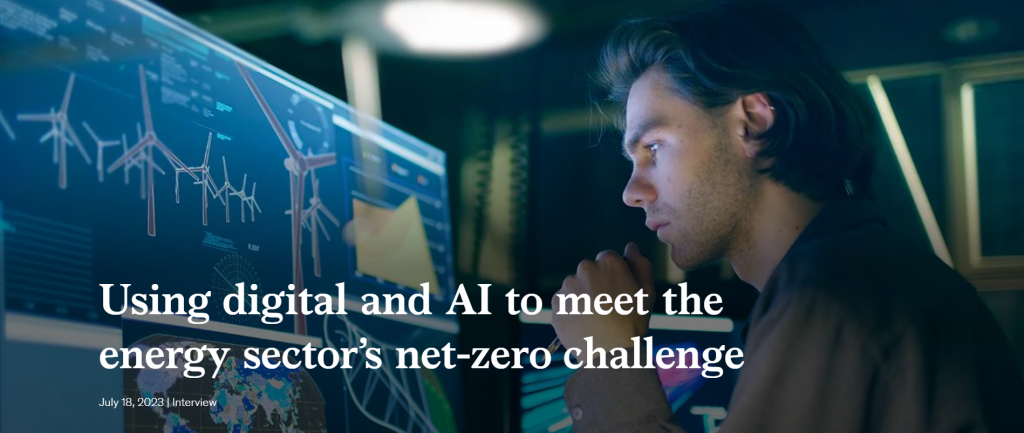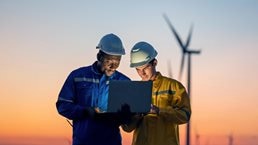Using digital and AI to meet the energy sector’s net-zero challenge

The success of clean energy from wind, solar, and other low-emission sources is vital for the global energy system to achieve net-zero emissions by 2050. While renewable energy has outperformed nearly all expectations in the past decade, many challenges loom large, including a scarcity of supply chain materials, limited availability of suitable land, lack of grid infrastructure investment, a slow permitting process, and pressure on returns.
With digital and AI capabilities increasingly embedded in organizations over the past five years, we wanted to hear firsthand how companies focused on renewable energy and sustainability are applying them to accelerate the net-zero transition: What initiatives are being driven by AI and digital? How can these technologies improve collaboration across the energy ecosystem? What new types of collaborative models will they support? What barriers do they face?
On the supply side, we spoke with Eduardo Medina, CEO of RES, the world’s largest independent renewable-energy company working across onshore and offshore wind, solar, green hydrogen, energy storage, and transmission and distribution. On the demand side, we engaged Greg Jackson, founder and CEO of Octopus Energy, which powers more than three million homes and businesses in the United Kingdom with renewable energy. On the technology side, we spoke with Kareem Yusuf, senior vice president at IBM, who leads the company’s sustainability initiative.
Our discussions were wide-ranging, but throughout them all, four shifts were seen by these leaders as being critical to the net-zero transition: the need to embrace true technology transformation, the recalibration from energy provider to software provider, the importance of sharing data across the ecosystem, and the potential impact of greater public-sector support.
Here we share edited comments from our conversations with these leaders to inspire others in the industry on ways to leverage these technologies toward a net-zero future.
Shift #1: From technology pilots to true transformation
Achieving value from digital and AI has historically been more challenging for energy companies than those in many other sectors. But these leaders make clear that sustainability and profitability depend on these technologies and that energy companies must move quickly to transform how they work if they are to successfully drive a net-zero transition.
Greg Jackson: To create a clean-energy system in a way that is good for consumers and good for businesses, we need to build the technology that lets us capitalize on the times when the sun is shining, the wind is blowing, and you’ve got this endless, abundant, zero-marginal-cost energy. Octopus alone generates about one and a half billion rows of data every day, and we have machine learning and algorithms running over that so that we can better forecast minute-to-minute consumption and generation, match them together, and then shift that consumption around or even relook at how (and where) the energy is being generated. If it’s cheapest to use renewables when they’re being generated, long-distance cables that connect generation areas with consumer demand will be increasingly important. One project under way at the moment is an undersea cable linking North Africa to the United Kingdom. It could provide around 7 percent of the UK’s electricity needs—or, to put it another way, power about seven million heat pumps reliably—every day of the year for ten to 12 hours a day.
Eduardo Medina: We are applying digital and analytical solutions across the entire company today. In our development business, the data and insights enable us to select the best sites for renewable-energy projects. This improves the value of our assets, which enables a better return for our clients. It also ensures we engineer our projects in an even more cost-effective way, manage geographic risks, improve our safety performance, and so much more.
For example, our UNO product remotely, autonomously, and continually monitors portfolios of turbines to identify anomalies in yaw alignment. This has led to corrective campaigns, resulting in better asset performance, better energy yield, improved safety, and lower operational costs.
Kareem Yusuf: When we talk about the energy space, we often talk about improving energy efficiency to reduce carbon emissions. But I like to focus on how to truly operationalize sustainability. How can you connect your decisions and sustainability goals to a business’s daily operations? First and foremost, you have to be able to measure and connect what’s actually occurring in your real-world environment. Only then can you take corrective actions. So I see these technologies coming together to let us better understand the problems. For example, AI-powered image recognition can remotely inspect a company’s physical assets, which can save time, money, and energy by avoiding in-person inspections. Depending on the size of operations and other details, this can add up to huge savings in energy. The challenge of achieving sustainability offers yet another opportunity to innovate.

Shift #2: From energy provider to software provider
These days it’s a cliché—but oh, so true—that every business is a software business. For companies like Octopus Energy and RES, achieving net zero will likely involve new ways of collaboration—often as a software provider rather than simply as an energy provider.
Greg Jackson: The energy industry has always been a hugely collaborative industry. Large oil companies that compete on the global stage, for instance, may have a joint venture in exploration and production, or one will have a chain of petroleum or gas retail stations buying wholesale from the others. But the new forms of collaboration could be quite different. For example, at Octopus Energy, we’ve created a full-stack system for running a 21st-century renewable-energy company, which we license to rivals and other companies around the world. This ability to collaborate in technology while competing in retail or generation characterizes the changes we’re seeing in energy today.
Eduardo Medina: RES has always been a pioneer. We built the UK’s second utility-scale wind farm in 1992, developed the world’s first offshore wind farms, and started deploying battery storage in 2014. Our in-house technical capability is continuing that pioneering trend by using machine learning to increase the energy yields for the asset owners. I see us expanding this area of the business to make these technology solutions available to the wider renewables market. Today we are a company with boots on the ground and a lot of engineers supported by data. In the next three to four years, we need to become a company driven by data and supported by engineers. This is where we are investing a lot in terms of machine learning and artificial intelligence.
Shift #3: From data silos to data-sharing ecosystems
In recent years, we’ve written about the benefits of data ecosystems that enable companies to build value through data sharing. As these leaders look to a net-zero future, they say greater transparency and data sharing across the energy ecosystem—by both providers and consumers—will be a must if the industry is to meet this goal.
Eduardo Medina: Collaboration across the energy space requires data. The two big challenges are in data protocols, where there is a lack of consistency, and in data sharing, where the majority of data remains hidden. For instance, the energy ecosystem would benefit from opening access to higher-frequency data sources that have historically been available only to the OEMs. Access to this data would drive more-advanced analytics and machine learning models, leading to higher availability of and increased performance from renewable assets.
Another example of where data sharing can be beneficial: one of the barriers to deploying more renewable energy can be constraints in the amount of electricity the power lines can carry. There are increasing efforts to achieve what are called “dynamic line ratings” that prevent a power line from being overloaded but still optimize its capability down to the last kilowatt. A simple example is to look at transmission capability in comparison to wind speeds, because wind cools power lines and allows more electricity to flow through them. Digital tools are enabling the industry to reach greater levels of sophistication and better utilization rates, but all of this requires cooperation and an overlay of grid compliance, which is crucial in a grid system.
Kareem Yusuf: Sustainability is definitely driving a conversation about collaboration. To reach net zero by 2050, we need forward-thinking, competent leaders in all parts of society—in both the economic and the political systems. We also need new, clear, agreed-upon data structures that easily represent information in the same way to all users. Collaboration also means technological collaboration, like standardizing data forms and data-exchange formats so they can be easily aligned around a common set of goals. We will also see collaboration around new AI foundation models, which are often trained on a broad set of unlabeled data. Such AI foundation models may ultimately help aid in the goal of net zero by making it easier for companies to apply AI toward sustainability.
Shift #4: From corporate transformation to community transformation
Much progress has been made in the past decade toward a net-zero future. The cost of renewables has significantly decreased. Global forecasts for solar capacity are 30 times higher than they were in 2021—and for wind capacity, both onshore and offshore, they are four times higher. Many more companies, including major oil and gas companies, are in the game. Now these leaders say that as energy companies transform their businesses to help solve the net-zero challenge, communities must transform how they manage energy.
Greg Jackson: I’m incredibly optimistic that we have the solutions on hand. I’m optimistic that there are plenty of companies that have the leadership to drive that change or that were founded to drive that change. What we need now is to open up the system so we can release the flow of capital and an incredible amount of invention and innovation that will create a better, cheaper system for consumers, with cleaner air, and reduce the impacts of climate change. In every advanced economy, you have some sort of grid that covers a state or a set of states and determines which innovations get connected, what it will cost, and how it will be charged. We really need to dramatically increase routes to market and create more contestability, so if you can build a company and find a customer for a particular shape of power, you can bring it to market very quickly and be able to compete against alternative models.
Eduardo Medina: I’m confident that the energy ecosystem will play a massive role in avoiding climate temperature rises, especially if we capitalize on electrification and the opportunity green hydrogen presents. However, the energy industry needs regulatory changes to speed up the deployment of renewables and that keep up with the pace of change needed to deliver the electricity network and enable net zero. The importance of supporting the buildout of the network cannot be overstated. We also need a willingness from governments to achieve net zero. Wind and solar are already the lowest-cost form of generation and can help reduce household energy bills.
Kareem Yusuf: With everything we’re facing—climate risk, environmental changes, the pandemic—one could really argue that these times are unique. But when you look back through history and think about the industrial revolution or about other pandemics and epidemics, such as smallpox and polio before vaccinations, these are issues that moved nations, governments, industry, and citizens to solve the problems. So while these times are somewhat unprecedented, we can find our way forward in how we communicate, collaborate, and come together, just as we have met such challenges before.
We are at a critical moment, where what we do now will forever shape our communities, our environment, and our planet. We are placing big bets on AI to help communities solve for some of the big crises many businesses are facing, including understanding and planning for changes in natural disaster patterns, biodiversity, land use, and other geophysical processes.
The post "Using digital and AI to meet the energy sector’s net-zero challenge" appeared first on McKinsey Insights

